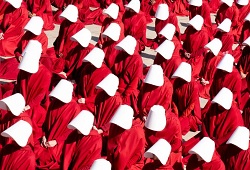
Margaret Atwood’s 1985 novel The Handmaid’s Tale depicts a dystopian future where a religious coup in the United States has given rise to a military dictatorship called Gilead. The rights of women have been stripped by the resulting patriarchal society, including the suppression of reproductive rights – the women of Gilead are forced against their will to bear children for the ruling elite. These “handmaids” are also restricted to wearing red cloaks with white bonnets to distinguish them from other social classes.
Atwood’s novel was developed in 2017 into a television series for Hulu. Shortly after its premier, groups of women began attending protests across the United States similarly dressed in red dresses and white bonnets, their heads bowed downward. According to the New York Times, the list of protest sites included the Missouri state capitol during budget debates, the Texas state capital to protest restrictive abortion laws, the statehouse in Columbus, Ohio, to protest a pending abortion bill, and a Planned Parenthood rally in Washington, D.C protesting a health care bill that would have reduced funding for the organization.
“All of the handmaids are subjected to listen to government officials, and they don’t have any kind of autonomy,” one of the D.C. protesters told the New York Times. “So for us as protesters it was a direct way to show how we are being silenced, and the government is not listening to us, and our rights are under attack and voices are not being heard.” She then added, “We weren’t verbally interactive, and it pushed people to ask and speak to Planned Parenthood volunteers who were around us and not in costumes.”
The idea emerged during a marketing stunt for The Handmaid’s Tale series at the SXSW conference in Austin, Texas. Hulu hired a number of women to dress as handmaids and silently stand outside to promote the show. A local pro-choice activist took notice and realized not only the symbolism but the social media potential of women similarly dressed at protests – such images would no doubt make their way to both social and mainstream media, raising awareness and ensuring greater coverage of the protests.
The strategy worked. Within a year, not only were “handmaids” regularly appearing at women and abortion rights protests in the United States but in South America and Europe as well.
“The handmaid’s costume has been adopted by women in many countries as a symbol of protest about various issues having to do with the requisitioning of women’s bodies by the state,” Margaret Atwood told The Guardian in August 2018. “Because it’s a visual symbol, women can use it without fear of being arrested for causing a disturbance, as they would be for shouting in places like legislatures. No one can accuse them of being immodest: they are well covered up. But everyone seeing these groups of women know what they mean in the context of the individual protest, whether it be Ireland, Argentina, or Arizona.”
Handmaid protesters were particular active in the United States during 2018, and even lined the balconies overlooking the entrance to a Senate office building during the Supreme Court confirmation hearings of Brett Kavanaugh. When Vice President Mike Pence visited Philadelphia for a Republican Party fundraiser, meanwhile, he was greeted by 100 handmaids. After then traveling to New York City for a cyber security summit, handmaids were again visible. Even Hollywood got involved, with actors, directors, and writers donning the red cloaks and white bonnets in support of the anti-harassment organization Time’s Up.
According to Vanity Affair, a post on the “Hollywood Handmaids” Facebook page stated, “We have been silenced, marginalized, belittled, assaulted, excluded, and harassed, once, twice, too many times. We are the ones who have learned that this is not one-off behavior – these are decades-old patterns upheld by systems.”
While both the handmaids of Margaret Atwood’s novel and the actual protesters were white, there was another segment of American society that had been “silenced, marginalized, belittled, assaulted, excluded, and harassed” for a lot longer than mere decades. Many female African American activists thus took exception to the Handmaid Protests, noting that Black women were the target of sexual violence during the slavery era of U.S. history and Puerto Rico women endured forced sterilization in the twentieth century.
“I don’t think there’s a problem with enjoying a show,” Alicia Sanchez Gill, executive director of the Emergent Fund, told the Los Angeles Times in June 2022. “We’re allowed to have joy and express outrage in the ways that makes sense for us. But when we rely too heavily on The Handmaid’s Tale, which ignores the presence of race and racism, it really dehumanizes and dismisses our collective experiences of reproductive trauma. Using The Handmaid’s Tale as a continued metaphor says to me that when these things were happening to folks of color, they cannot fully empathize.”
While the future of the Handmaid Protests is uncertain, protests for women and reproductive rights continue across the country and around the world – one doesn’t need a fictional dystopian future, after all, to understand the necessity when the past is littered with its own atrocities.
Anthony Letizia

